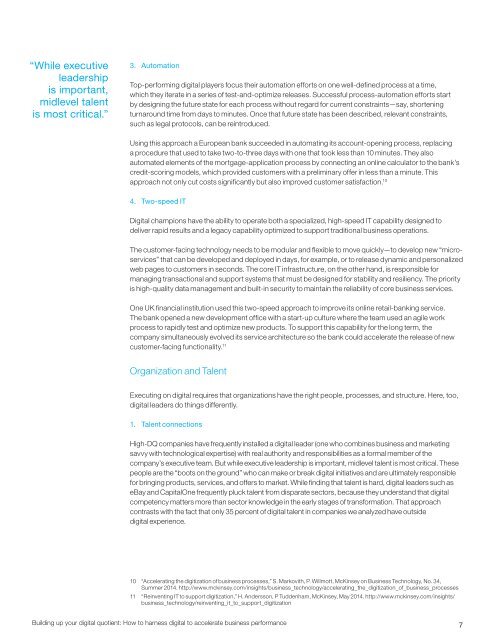Digital-Quotient
Digital-Quotient
Digital-Quotient
You also want an ePaper? Increase the reach of your titles
YUMPU automatically turns print PDFs into web optimized ePapers that Google loves.
“While executive<br />
leadership<br />
is important,<br />
midlevel talent<br />
is most critical.”<br />
3. Automation<br />
Top-performing digital players focus their automation efforts on one well-defined process at a time,<br />
which they iterate in a series of test-and-optimize releases. Successful process-automation efforts start<br />
by designing the future state for each process without regard for current constraints—say, shortening<br />
turnaround time from days to minutes. Once that future state has been described, relevant constraints,<br />
such as legal protocols, can be reintroduced.<br />
Using this approach a European bank succeeded in automating its account-opening process, replacing<br />
a procedure that used to take two-to-three days with one that took less than 10 minutes. They also<br />
automated elements of the mortgage-application process by connecting an online calculator to the bank’s<br />
credit-scoring models, which provided customers with a preliminary offer in less than a minute. This<br />
approach not only cut costs significantly but also improved customer satisfaction. 10<br />
4. Two-speed IT<br />
<strong>Digital</strong> champions have the ability to operate both a specialized, high-speed IT capability designed to<br />
deliver rapid results and a legacy capability optimized to support traditional business operations.<br />
The customer-facing technology needs to be modular and flexible to move quickly—to develop new “microservices”<br />
that can be developed and deployed in days, for example, or to release dynamic and personalized<br />
web pages to customers in seconds. The core IT infrastructure, on the other hand, is responsible for<br />
managing transactional and support systems that must be designed for stability and resiliency. The priority<br />
is high-quality data management and built-in security to maintain the reliability of core business services.<br />
One UK financial institution used this two-speed approach to improve its online retail-banking service.<br />
The bank opened a new development office with a start-up culture where the team used an agile work<br />
process to rapidly test and optimize new products. To support this capability for the long term, the<br />
company simultaneously evolved its service architecture so the bank could accelerate the release of new<br />
customer-facing functionality. 11<br />
Organization and Talent<br />
Executing on digital requires that organizations have the right people, processes, and structure. Here, too,<br />
digital leaders do things differently.<br />
1. Talent connections<br />
High-DQ companies have frequently installed a digital leader (one who combines business and marketing<br />
savvy with technological expertise) with real authority and responsibilities as a formal member of the<br />
company’s executive team. But while executive leadership is important, midlevel talent is most critical. These<br />
people are the “boots on the ground” who can make or break digital initiatives and are ultimately responsible<br />
for bringing products, services, and offers to market. While finding that talent is hard, digital leaders such as<br />
eBay and CapitalOne frequently pluck talent from disparate sectors, because they understand that digital<br />
competency matters more than sector knowledge in the early stages of transformation. That approach<br />
contrasts with the fact that only 35 percent of digital talent in companies we analyzed have outside<br />
digital experience.<br />
10 “Accelerating the digitization of business processes,” S. Markovith, P. Willmott, McKinsey on Business Technology, No. 34,<br />
Summer 2014. http://www.mckinsey.com/insights/business_technology/accelerating_the_digitization_of_business_processes<br />
11 “Reinventing IT to support digitization,” H. Andersson, P Tuddenham, McKinsey, May 2014. http://www.mckinsey.com/insights/<br />
business_technology/reinventing_it_to_support_digitization<br />
Building up your digital quotient: How to harness digital to accelerate business performance<br />
7


